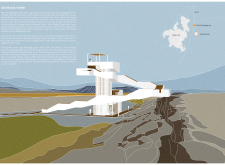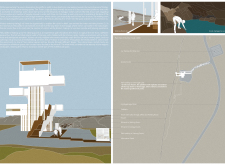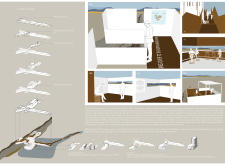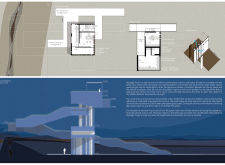5 key facts about this project
The primary function of the Grjótagjá Tower is to facilitate tourism by providing amenities such as waiting areas, offices, and viewing platforms. The structure incorporates various spaces, including a cafeteria and storage rooms, creating an inviting environment for visitors. The architectural design optimizes visitor flow, guiding patrons from the parking area through well-planned pathways into the tower and towards scenic viewpoints.
The design of the Grjótagjá Tower exhibits several unique characteristics that differentiate it from other visitor centers. Firstly, the structure features a combination of materials that prioritize both aesthetics and functionality. The use of steel for the core structure ensures stability while allowing flexibility in form. The exterior is clad in thin white metal sheets, contrasting with the black vertical cedar siding of the walking platforms. This deliberate choice of materials not only withstands the harsh Icelandic climate but also aligns with the project's goal of minimizing ecological disruption.
Another notable feature is the integration of triple-layered glass panels that enhance natural light while maintaining energy efficiency. This design approach allows for panoramic views of the surrounding landscape, encouraging a connection between the visitors and the geological formations they are exploring. The efficient insulation methods provide necessary thermal control, ensuring a comfortable interior climate throughout the year.
The pathways within the Grjótagjá Tower are designed to promote exploration and engagement. Various viewpoints strategically placed throughout the structure offer visitors opportunities to witness the interplay of light, water, and the unique geological structure of the area. This curated experience encourages contemplation and a deeper understanding of the site’s natural significance.
In design, the Grjótagjá Tower stands out due to its focus on sustainability and minimal environmental impact. The structure was conceived to require minimal excavation, preserving the natural contours of the landscape. The thoughtful arrangement of spaces fosters connectivity with the surrounding environment while promoting educational opportunities regarding Iceland’s geological narrative.
Those interested in further exploring the architectural context of Grjótagjá Tower should refer to the detailed architectural plans, sections, and design elements. These resources provide insights into the project's development, contextual relationship with the landscape, and the innovative ideas that shaped its construction.


























